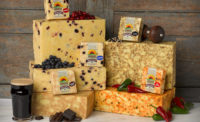Flavored cheeses add distinction and generate interest
But there are several factors to consider when producing cheeses that include flavor inclusions.

With more than two-thirds of households purchasing flavored cheese and over 283 million pounds sold in 2016 alone, there is no denying that this category is generating a lot of interest. In fact, nearly 300 new flavored cheese products were added to the market last year, flaunting flavors such as jalapeño, smoked, herb, pimento, taco, berry, alcohol, bacon, citrus and coffee.
While flavor additions offer cheesemakers a chance to be creative and potentially set themselves apart from the competition, you’ll want to consider a few things before adding a little zest to your next vat.
Working with flavor varieties
One of the first steps is deciding what flavor addition to pursue. During this developmental stage, it is best to use a combination of market research and a thorough knowledge of your base product to determine what flavor will best align with that product and your goals.
For example, according to reports generated by the Wisconsin Milk Marketing Board, fast-growing flavors include herb, pimento, habanero and garlic, so including one of those in your product may be a smart business idea. If, however, you make a product such as Gouda that has a subtle, nutty flavor, it may pair better with a chewy apricot or a crunchy almond flavor rather than the ever-popular hot pepper. In other words, different cheese varieties work better with different flavors (e.g., Monterey Jack is often used as a base for hot peppers), so keep your base product in mind when making such decisions.
Additionally, the actual texture, aging process and preferred cosmetic look of your cheese should be considered as you select your flavor. You will also want to consider how you will add the flavor to your cheese product. Will it be rubbed on the outside, mixed directly into the cheese, or both? All of this will, in turn, affect how the product will look and taste.
Applications research at the Center for Dairy Research suggests that for sweets, the flavor addition should make up about 1% to 2% of the total weight of the cheese; for peppers, about 0.25% to 0.50%; for herbs and spices, about 0.05% to 0.15%; and for hot peppers, about 0.05% to 0.50%. In general, you want a flavor that enhances the base cheese rather than masks or overpowers its original flavor.
Processing flavored cheeses
In addition to selecting an appropriate flavor, the make procedure — including safety and quality measures — must be considered early on in the process. For example, some inclusion flavors may impact curd knit, which can negatively influence machinability. Flavors can also alter the pH of cheese or add some unwanted fermentable sugar. And while spices can provide companies with a unique differentiating factor, they can also harbor microbes that can cause significant issues for cheesemakers, including spoilage and unwanted gas formation. Purchasing spices, herbs and other flavors from a supplier with a certificate of analysis and good manufacturing practices in place is a step in the right direction.
Moisture migration around salty flavorings can also be a problem, as can bleaching/texture changes around pieces, so do your research and select a flavor that fits your safety/quality needs and your consumers’ expectations. Also, remember that the addition of some flavors may introduce an allergen such as nuts or shellfish into your facility, so be cautious about how that will affect your manufacturing practices and labeling.
There are many things to consider when adding a flavor to your cheese. Risks do exist, but as flavored cheese growth outperforms the rest of the cheese category, there will be further interest in creating high-quality, distinctive-flavored cheese products that meet consumer demands.
Looking for a reprint of this article?
From high-res PDFs to custom plaques, order your copy today!







